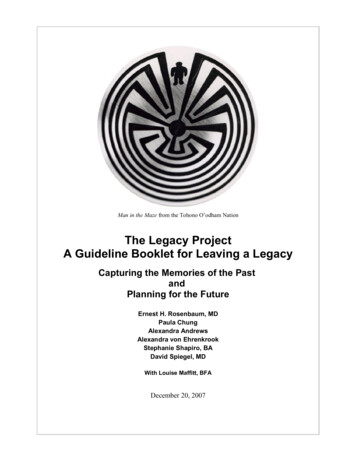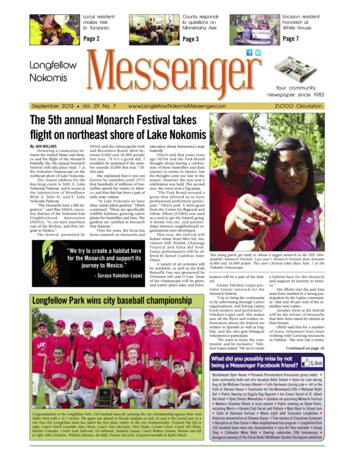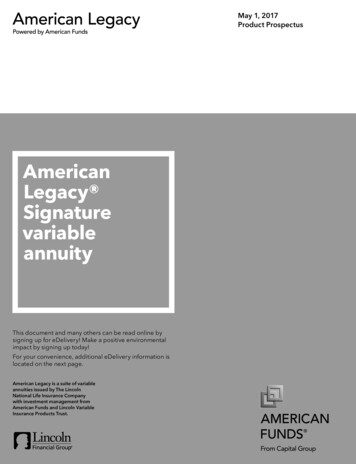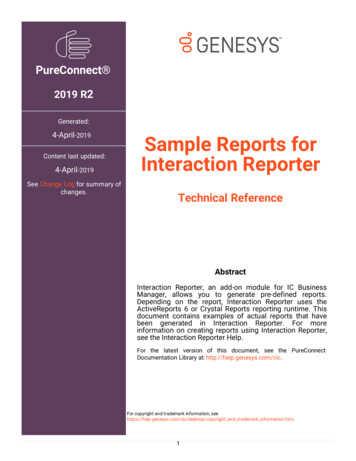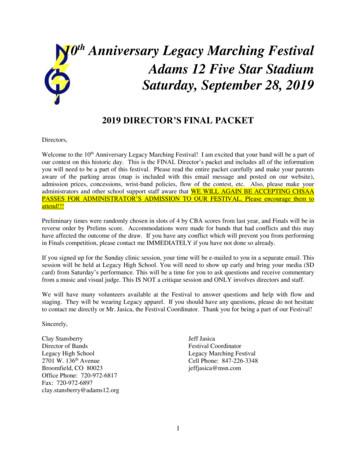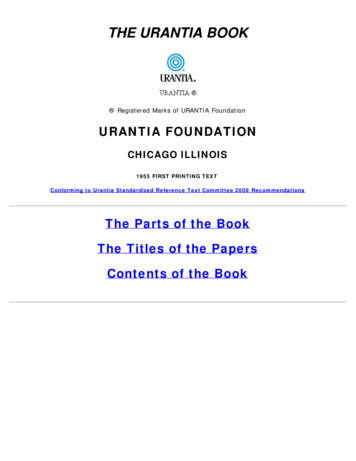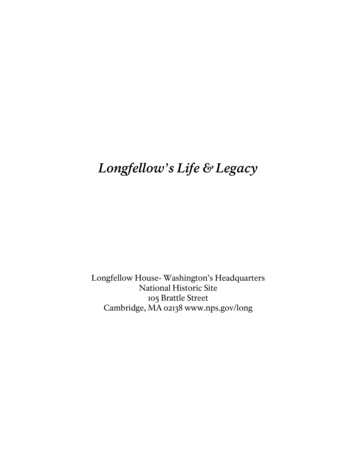
Transcription
Longfellow’s Life & LegacyLongfellow House- Washington’s HeadquartersNational Historic Site105 Brattle StreetCambridge, MA 02138 www.nps.gov/long
Table of ContentsIntroduction.3Biographical Information . 1Henry Wadsworth Longfellow 1807 - 1882 . 2Henry Wadsworth Longfellow: Biographical Highlights . 4Henry Wadsworth Longfellow: A Biography . 5America’s Longfellow. 8Poems and Primary Sources . 14The Children’s Hour, 1859 . 15Alice, Annie Allegra, and Edith . 16from To a Child, 1845 . 17The Castle- Builder, 1848. 17Charles and Ernest Longfellow. 18Drawings and Paintings by the Longfellow Children . 19The Village Blacksmith, 1839 . 21From my Arm- Chair, 1879 .23Travels by the Fireside, 1874 .25The Slave in the Dismal Swamp, 1842 . 27Haunted Houses, 1852 . 29The Builders, 1846 . 31Charles Sumner, 1874 . 33Charles Sumner . 34Recommended Resources . 35Henry Wadsworth Longfellow . 35The Longfellow Family . 35Poetry, Writing and Literature . 35The National Park System Caring for America's Treasures . 36
IntroductionLongfellow House- Washington’s Headquarters National Historic Site is aunit of the National Park Service that preserves and interprets the historicstructures, grounds and collections associated with the life and work of thenation’s first professional poet who engaged the major social, political andcultural questions of his day through poetry that engaged the mind andpleased the senses.Longfellow’s poems continue to resonate – inviting new generations tothink about the power of words and the marvel of human ingenuity. Thepark offers several curriculum- based programs for student groups in theGreater Boston area, and is pleased to now offer educators a downloadableteacher packet with materials suitable for classroom use.This packet, Longfellow’s Life & Legacy, includes biographical informationon Henry Wadsworth Longfellow for students of all ages. In addition thepacket includes an extensive bibliography with suggested readings forteachers and students, and a variety of primary source materials – historicphotographs, poems, and quotes – suitable for classroom use. Allphotographs and documents in this packet are courtesy of the NationalPark Service, Longfellow House- Washington’s Headquarters NationalHistoric Site.Developed by Liza Stearns, Education SpecialistRevised 2017
Biographical Information1
Henry Wadsworth Longfellow 1807 - 1882 *Feb. 27, 1807Henry Wadsworth Longfellow born in Portland, Maine1820Longfellow publishes his first poem, “The Battle ofLovell’s Pond” from Voices of the Night1825Longfellow graduates from Bowdoin College1826 - 1829Longfellow travels to Europe to study language andliterature1831Longfellow marries Mary Storer Potter1835 - 1836Longfellow travels to Europe 1835 Mary PotterLongfellow dies1836Longfellow begins teaching at Harvard as Smith Professorof Modern Languages1837Longfellow moves into Craigie House, 105 Brattle Street,Cambridge, Massachusetts1839The Village Blacksmith1842“The Slave in the Dismal Swamp” from Poems on SlaveryJuly 13, 1843Longfellow marries Fanny Appleton - her father, textilemanufacturer Nathan Appleton, purchases Craigie Houseas a wedding gift1844Charles Appleton Longfellow is born1845Ernest Wadsworth Longfellow is born1846“The Builders” from The Seaside and the Fireside1847Fanny Longfellow, Henry and Fanny’s first daughter isPoems are listed according to the year in which they were composed and finished. Collections in which the poemsappear may have been published at a later date.*2
born1847Evangeline: A Tale of Acadie1848Daughter Fanny Longfellow dies1850Alice Mary Longfellow is born1853Edith Longfellow is born1854Longfellow resigns from position at Harvard1855Anne Allegra Longfellow is born1855Song of Hiawatha1859“The Children’s Hour” from Birds of Passage1860“Paul Revere’s Ride” from Tales from a Wayside InnJuly, 1861Fanny Appleton Longfellow diesMarch, 1863Charley Longfellow enlists in the Union Army1869Longfellow completes his last European tour1874Charles Sumner (Longfellow’s best friend) dies,Longfellow writes “Charles Sumner” from Birds ofPassage1879“From my Arm- Chair” from Ultima ThuleMarch 24, 1882Henry Wadsworth Longfellow dies in Cambridge3
Henry Wadsworth Longfellow: Biographical Highlights Henry Wadsworth Longfellow, one of America’s most famous and bestloved poets, lived over one hundred years ago (1807- 1882). Longfellow was born in 1807. He grew up in Maine and went to BowdoinCollege in Brunswick, Maine. In 1831, Longfellow married Mary Potter. She died four years later.Longfellow was grief- stricken over her death, and wrote poems thatreflected his feelings. In 1836, Longfellow moved to Cambridge, Massachusetts to teachforeign languages at Harvard College. He spoke at least eight languageswell and could read and write four others. Longfellow composed his first famous poem, "Psalm of Life," in 1838. Longfellow married Frances Appleton in 1843. Her father purchased theCambridge house in which Longfellow was renting rooms as a weddinggift for them. The house had been a Revolutionary War headquarters forGeneral George Washington. Evangeline (1847), a very popular narrative poem, brought Longfellow agreat deal of attention. By the time he was 47, his success enabled him toleave teaching and devote himself to writing poetry. Longfellow wrote many famous poems, including "Paul Revere’s Ride"(1860) and The Song of Hiawatha (1855). He wrote poetry about hisfeelings and experiences, and also wrote epic poems that told stories. Frances (known as Fanny) and Henry raised five children. A sixth childdied in infancy. Longfellow was very close to his family and enjoyedspending time with his children. His family life and experiences inspiredmany of his poems. Strangers often came to Longfellow’s home hoping to catch a glimpse ofhim. He frequently invited them in and spent hours visiting with them. By the time of his death (1882), Longfellow’s poems were known andcelebrated around the world.4
Henry Wadsworth Longfellow: A BiographyEarly YearsHenry Wadsworth Longfellow was born in Portland, Maineon February 27, 1807. His mother, the former ZilpahWadsworth, was the daughter of General Peleg Wadsworth ofRevolutionary War fame and a descendent of passengers onthe Mayflower. His father, Stephen, was a noted Portland lawyer whoserved in the Massachusetts State Legislature and United States Congress.Second in a family of eight children, Henry enjoyed a happy and activeboyhood. He was enrolled at age three in a traditional “dame” school andlater attended the Portland Academy and Bowdoin College in Maine wherehis classmates included Nathaniel Hawthorne and Franklin Pierce.Career and MarriageRecognizing his fine academic record, the Bowdoin trustees offeredLongfellow a professorship in Modern Languages upon graduation in 1825.The position required travel abroad to prepare for his duties. Longfellowstudied in France, Spain, Italy, and Germany. In 1829, he returned toBowdoin where he spent six successful and productive years teaching,publishing textbooks, and writing articles for popular literary reviews.In 1831, Longfellow married Mary Storer Potter. The two lived in Maine forseveral years until Longfellow was offered a position as head of the ModernLanguage Department at Harvard College in Cambridge, Massachusetts.Once again, he journeyed to Europe for preparatory study. Mary was takenill on this trip and, in November, 1835, died in Rotterdam, Netherlands.Suffering great sorrow at his loss, Longfellow plunged into diligent studyand spent the following winter and spring in Heidelberg perfecting hisGerman. He met the Appletons of Boston’s fashionable Beacon Hill in 1836while summering in Switzerland. Nathan Appleton was a prominentbanker, manufacturer, and politician who made his fortune in the textileindustry. His daughter, Frances Elizabeth (Fanny), captivated Longfellow’sattentions, but her interest in him was not immediately returned. The5
young professor left soon after for America and his duties at Harvard.Cambridge LifeSeeking residence in Cambridge, Longfellow persuaded Elizabeth Craigieto accept him as a lodger at her comfortable home on Brattle Street with itsviews of the Charles River. His first writings were published during theseyears: Hyperion, A Romance, and Voices of the Night.Fanny Appleton, experiencing a change of mind and heart after severalyears of courtship, married Henry Longfellow on July 13, 1843. Her fatherpurchased the Craigie house later that year and presented it and thesurrounding grounds to the Longfellows as a wedding gift. Thus beganeighteen years of devoted marriage during which time two sons and fourdaughters were born.Well- educated and traveled, Fanny was a perceptive critic of art andliterature who happily shared her husband’s pursuits. The couple wasseldom apart. Once, while reluctantly attending a ball without his wife,Longfellow lamented that “the light seemed dimmer, the music softer, theflowers fewer, and the women less fair.”Poet and FriendIn 1854, Longfellow resigned from Harvard and devoted himself to writing.Such important works as Evangeline, The Song of Hiawatha, and Courtship ofMiles Standish – all published between 1847 and 1858 – brought him greatpopularity and fame. He also spent many hours entertaining notable friendssuch as Nathaniel Hawthorne, Ralph Waldo Emerson, Charles Sumner,and Cornelius Felton, who later became president of Harvard.Success, tranquility, and happiness were shattered in 1861 when FannyLongfellow suffered fatal burns while sealing packets of her children’slocks of hair for keepsakes. She was buried in Mount Auburn Cemetery inCambridge on the eighteenth anniversary of their wedding day.Later YearsIn the years following Fanny's death, Longfellow gradually put his life back6
together again. He continued to reside in the house they had shared andserved as both father and mother to the children. His remaining yearsbrought forth such popular and esteemed works as Tales of the Wayside Innwith its “Paul Revere’s Ride.” The poet also made his last trip to Europewhere he was honored by the Queen of England, received honorarydegrees from Oxford and Cambridge, and visited Charles Dickens andAlfred Lord Tennyson.Often an unusual mix of despair and encouragement, Longfellow’s poetrystruck a responsive chord in the nation’s collective heart and mind. His wasa full and admired life, the legacy of which continues to prompt anenthusiasm for America’s people and past. Revered by his contemporariesand touted as “the people’s poet,” it is important to remember his simplicityof spirit. In 1879, three years before his death in 1882, Longfellow received agift from the children of Cambridge: a chair made of wood from the“spreading chestnut tree” immortalized in his poem The Village Blacksmith. Itwas a gesture returning to the poet a bit of the love he had given to his ownand other children.Ah? What would the world be to usIf the children were no more?We should dread the desert behind usWorse than the dark before.7
America’s LongfellowAn Essay by Matthew Gartner, December 2, 2002IntroductionLongfellow is one of the monumental cultural figures of nineteenthcentury America, the nation's preeminent poet in his era, whose verse isnotable for its lyric beauty, its gentle moralizing, and its immensepopularity. A New Englander through and through who traveled widely inEurope and knew a dozen languages, a Harvard professor, and thecountry's first professional poet, Longfellow heralded a new spirit inAmerican letters. His fame grew until it took on a life of its own, and he wasrevered and beloved to a degree few poets have been before or since.When Longfellow began his literary career in the 1820s, poetry oftenseemed a needless luxury to the practical- minded citizens of the stillyoung American republic; along with such other genteel poets as WilliamCullen Bryant, Oliver Wendell Holmes, and James Russell Lowell,Longfellow played an important role not just in helping make poetryrespectable, but more broadly in refining and cultivating middle- classreaders. In the gentle hands of Longfellow, readers could be introduced tothe finer things in life – domestic sympathies, noble aspirations, spiritualconsolations, the glories of high culture – without ever being made to feelintimidated or inadequate. A peculiarly American mixture, Longfellow wasboth a patrician and a populist, an artist of elite social background whosewriting reverberated with the masses. One reader, a Mrs. Julia Willard,captured the experience of many when she wrote Longfellow, late in hislife, "Your beautiful poems have been a rest, a blessing, a sweet, pure,calming benediction to me ever since I learned to read them in mychildhood years."Over and above his poetry's success and influence, Longfellow becamehimself a living icon who filled a central niche on the American scene.Americans read his poetry by firesides, in schools, at public occasions; theyheard musical renditions sung in parlors and concert- halls; their childrencelebrated his birthday in school and memorized and recited his poems.Because of his singularly large reputation, a result not only of the place he13America's LongfellowEssay by Matthew Gartner, December 2002
carved out for himself but also of sustained promotional efforts on the partof his publishers and defenders, Longfellow became a looming presence, animportant symbol for his fellow Americans, representing a set of values andmeanings that changed as the country did through the century. Althoughhis reputation declined precipitously after his death in 1882, a Longfellowrevival of kinds may now be under way as it becomes possible to see afreshhis considerable poetic achievements and historical significance.PoetryThe nature of Longfellow's poetic genius is elusive, hard to pin down,though it may help to recall that first and foremost he was a public poet.That is to say, he always wrote with his audience in mind, paternallyconsoling and uplifting them in lyrics, ballads, odes, sonnets, verse dramas,and the long narrative poems whose characters became hallmarks ofAmerican culture: Evangeline, Hiawatha, the Puritan maiden Priscilla, themidnight- riding Paul Revere. The essential note of his poetry, its sweet andsettling mildness, its serene reassurance, was perfectly modulated to appealto the reading public. This was socially responsible poetry, poetry withpurpose, whose often explicit message urged such virtues as patience,resignation, and hard work.Given these themes, it seems fitting that as a poetical craftsman he was notboldly original or radically experimental, as were his contemporaries WaltWhitman and Emily Dickinson. Rather, Longfellow fashioned his poemsout of tried- and- true materials: accessible ideas and language, pleasingstories and rhyme, familiar feelings and form. In a well- known lyric from1844, "The Day Is Done," Longfellow voiced what may be thought of as hispoetic intentions; in this poem about poetry – a favorite subject of his – hecelebrates poems that "have power to quiet/The restless pulse of care,/Andcome like the benediction/That follows after prayer." In these direct, clear,and mellifluous lines, one can see how Longfellow is content to speaksimply and softly; indeed, he adopted as a personal motto a Latin phrase,Non clamor sed amor, borrowed from an anonymous poem he himselftranslated: "Not loudness but love." The great American author NathanielHawthorne, a friend and college classmate of Longfellow's, praised just thisunderstated quality: "No one but you would have dared to write so quiet abook," he wrote in an 1850 letter to Longfellow. The remark highlights the13America's LongfellowEssay by Matthew Gartner, December 2002
way Longfellow's literary strength lies not in breaking rules but in followingthem, not in transgressing but in staying within bounds. Longfellow alwaysfelt himself dutifully answerable to his readers – he was a poet, quiteliterally, with a known address – and this sense of public obligation shapedhis poetry and his life in fundamental ways.Though Longfellow was hardly a poet of the startlingly new, he undeniablydid break new ground in American poetry, and this was in large part due tothe way that, in him, expressive poetic genius met and battled with thestolid forces of New England repression. The result was a strange kind ofpoetry, shuttling between America and Europe, between Puritan reticenceand Romantic feeling, between pious instruction and aesthetic pleasure,between aristocratic ideals and egalitarian principle. Longfellow held theseoppositions together by keeping his poetry's energies oriented toward hisreaders. In other words, the popular success of this often selfcontradictory poet may have been possible only because the United Statesin the mid- to- late nineteenth century was such a conflicted place.Longfellow managed to speak to the conflicts and at the same time to seema safe haven, an anchor in the storm.Life and FameLongfellow's benign poetic temperament owes much to his full andfortunate life. Born in Portland in 1807, when that bustling port city was stillpart of Massachusetts, Longfellow came from an old, established family oflawyers, judges, and generals. Enrolled at Bowdoin College by the age offourteen, during his senior year Longfellow published no less than sixteenpoems in a leading literary journal, the United States Literary Gazette. Upon hisgraduation the Bowdoin trustees (his father conveniently happened to beone!) appointed him to a provisional professorship, sending him off toEurope for three years of preparatory study.He stayed for four, returning to Maine to start his teaching career in 1829.His next years were productive ones, and his ambition, hard work, andsocial connections paid off when in 1835 – at the age of 28 – he was offeredthe most prestigious position in his field (what we would now call "Comp.Lit.") that the country had to offer: the Smith Professorship of ModernLanguages at Harvard. Granted a year to travel in Europe before taking up13America's LongfellowEssay by Matthew Gartner, December 2002
his duties, Longfellow was in Rotterdam with his wife Mary PotterLongfellow when she suffered a miscarriage and died from itscomplications. Distraught, he continued to drift through Europe for therest of the year. Installed at last in Cambridge in the fall of 1836, the major,most productive and important phase of his life was about to begin.This phase was marked by his return, after an almost ten year interruption,to writing poetry. His breakthrough poem, "A Psalm of Life," published inthe Knickerbocker magazine out of New York and reprinted in newspapersacross the country, stirred a generation of readers with its headyexhortations:Life is real! Life is earnest!And the grave is not its goal;Dust thou art, to dust returnest,Was not spoken of the soul.Not enjoyment, and not sorrow,Is our destined end or way;But to act, that each to- morrowFind us farther than today.With the publication in 1839 of his first collection of poems, Voices of theNight, and that same year of his novel Hyperion, Longfellow establishedhimself as one of America's leading authors. Still in his early thirties, a welldressed, cosmopolitan figure in small- town Cambridge, Longfellowformed close friendships with other young men of patrician backgroundsand promising futures, and turned his attention to the daughter of aprosperous Boston industrialist, Fanny Appleton, whom he had met for thefirst time in Switzerland in the summer of 1836. Unusually determined as asuitor, Longfellow waited seven long years before she relented, and the twowere married in 1843. As a wedding present her father, Nathan Appleton,bought the couple the historic Craigie House on Brattle Street, a short walkfrom Harvard Square (Longfellow had been renting rooms there since 1837,and the house came on the market at a fortuitous moment). Henry andFanny raised five children in Craigie House, and lived among friends andfamily in great comfort, happiness, and privilege. It is revealing of theLongfellows' elite social position, for instance, that in 1847 Fanny becamethe first woman in America to be given anesthesia during childbirth.13America's LongfellowEssay by Matthew Gartner, December 2002
Moderate in politics, liberal in religion, Professor Longfellow and his wifesurrounded themselves with art, music, and books; they had dinner parties,kept up wide- ranging correspondences, and spent their summers inNahant, by the shore.Meanwhile, Longfellow's literary career prospered and his fame spread. Inthis matter of his career, Longfellow must never be confused for a privatecitizen, a solitary scrivener, alone in his attic pouring forth his soul. Rather,throughout his writing life Longfellow had behind him the powerful NewEngland establishment, of which – as a Harvard professor and worldfamous author – he became a leading representative. He counted among hisfriends the influential figures of the day in culture, politics, and society, andhe in turn could be counted on to voice irreproachably respectable idealsgrounded in moral decency and concern for the public good. As an avatarof the emerging Boston culture industry, Longfellow was not just a moralemblem but a profitable venture: his books sold extraordinarily well. Hewrote prolifically, and his publishers – first Ticknor and Fields, laterHoughton Mifflin – were constantly bringing out new volumes and neweditions of his collected poems, at all different price points for differentsegments of the expanding book trade. Longfellow was frequently profiledin newspapers and magazines, and the release of poems like The Song ofHiawatha in 1854 and The Courtship of Miles Standish in 1858 were"events" shrewdly orchestrated to maximize sales. Even in his own lifetime,therefore, Longfellow was larger than life, an institution associated with anarray of ideological, social, and commercial interests. Longfellow was oftenhappiest when paying least attention to such matters, but his public auraforms a scrim against which his private self must be seen.Longfellow's domestic happiness was shattered in 1861, when his wifeFanny died of burns after fire engulfed her from a candle accidentallyknocked over as she was melting wax to seal locks of her children's hair. Awidower once again, never to remarry, Longfellow continued to raise thechildren – the oldest was fourteen, the youngest five at the time of thetragedy – and, perhaps to drown his grief, continued to write: lyric poems,the narrative poems collected in Tales of a Wayside Inn, verse dramas, andhis landmark three- volume translation of Dante's Divine Comedy. Hisimpressive output never slowing down, in the last decade of his lifeLongfellow published five new collections of poems, as well as assorted13America's LongfellowEssay by Matthew Gartner, December 2002
other writings. By the time he died, aged 75, in March 1882, at his home inCambridge, he had become a national elder, a white- bearded eminencewhose Jove- like image was widely circulated in lithographs andphotographs.Sarah Orne Jewett captured something of the importance of Longfellow inthe national imagination when she wrote in eulogy, "It is a grander thingthan we can wholly grasp, that life of his, a wonderful life . . . . This worldcould hardly ask any more from him: he has done so much for it, and thenews of his death takes away from most people nothing of his life. His workstands like a great cathedral in which the world may worship and be taughtto pray, long after its tired architect goes home to rest."Home and Home LifeJewett could refer so knowingly to "[t]hat life of his, a wonderful life"because its basic outlines were a point of public fascination, anindispensable part of the Longfellow legend. The patrician ancestry, theEuropean travels, the early loss of his first wife, the Harvard professorship,the long courtship of Fanny Appleton, the five children, the historic oldhouse in which they peaceably lived, the steadily mounting fame - theseitems hardly bore repeating in the popular press, so great was Longfellow'scelebrity, and yet were repeated nonetheless. Craigie House (named for aformer owner, Andrew Craigie, an apothecary) became a focal point ofLongfellow's fame, which rested to some large extent on his life and evenhis lifestyle.This was a period when private life and the private home took on newpublic importance, and Longfellow's prestige and authority as a kind ofnational father figure could seem all the greater by dint of his owning such aplace. The house itself, an imposing late- Georgian mansion painted aproper yellow with white trim and black shutters, bespoke affluence,dignity, and tradition. Early in the Revolutionary War it had served asWashington's military headquarters, and hence came down to Longfellowas a patriotic treasure; images of it were frequently reproduced in editionsof Longfellow's works, as well as in pictorial magazines, postcards,advertisements, and such other popular media of the times as stereopticoncards. No other author's home, with the possible exception of Washington13America's LongfellowEssay by Matthew Gartner, December 2002
Irving's Sunnyside, could rival Craigie House in fame. With the emergence of the Colonial Revival movement in American architecture, manyreplica Craigie Houses appeared around the country – the first built in 1883in Maine, the second in 1887 outside Chicago.Craigie House appeared in Longfellow's poetry too, where it comes acrossas a place of familial contentment. In poems like "To a Child" and"Children," Longfellow seemed to invite readers into his home, openingthe door (just a crack!) onto his family life: such glimpses gave readers theillusion that they knew the illustrious Professor Longfellow in his intimatedomestic moments. In "The Children's Hour," for instance, Longfellowimagines his well- behaved daughters – "Grave Alice, and laughing Allegra, /And Edith with golden hair" – granted leave to come into his famous studyto play with him at the end of his work day; the father's affection ispalpable. Longfellow earned the love and respect, the tenderness andreverence of his readers, then, not just as a poet but as a model husband andfather, a father figure, with a privileged home life that could be glimpsed, attimes, in his writing. The success of this self- representation may be judgedfrom an 1880 letter written by the novelist Henry James to his mother;James, in London, wrote of a British lord who one day over lunch came outwith the thought that "his ideal of the happy life was that of Cambridge,Mass., 'living like Longfellow.'"Reputation and PopularityLongfellow's reputation grew so large that the reputation itself became alegend, subject to all the falsehoods of the legendary. Contrary to thepopular wisdom that Longfellow was almost unanimously adored in thenineteenth- century, with a few grumpy exceptions like Edgar Allan Poeand Margaret Fuller, the truth is that he was always controversial, alwayscontested. Reviewers and editors in the newspapers and magazines tooksides, often not merely on literary but on ideological grounds. Thequestions that concerned the critics – was Longfellow original or derivative,was he "American" enough or too European, was he "in touch" or was hetoo cloistered, were his metrical choices fitting? – masked deeper rifts in thecountry over regional influence, the ascendancy of bourgeois manners, themoral responsibilities of art and artists, and the distribution of culturalpower. At the beginning of his career,
Longfellow wrote many famous poems, including "Paul Revere’s Ride" (1860) and The Song of Hiawatha (1855). He wrote poetry about his feelings and experiences, and also wrote epic poems that told stories. Fra

